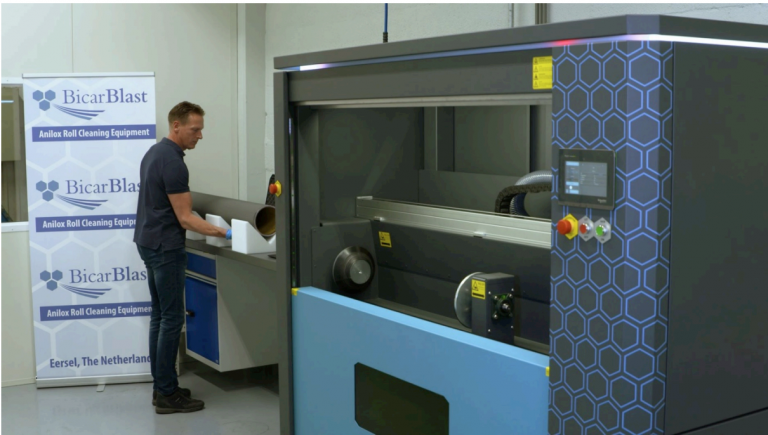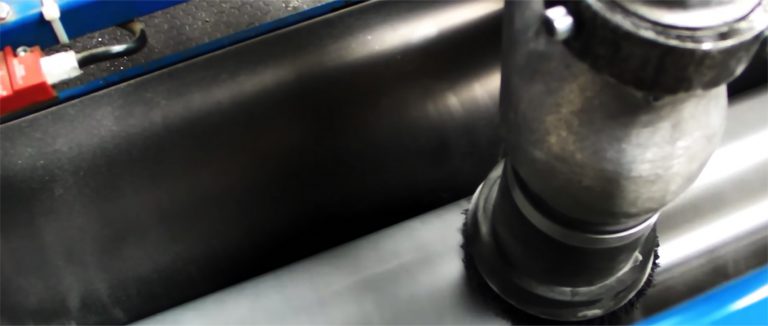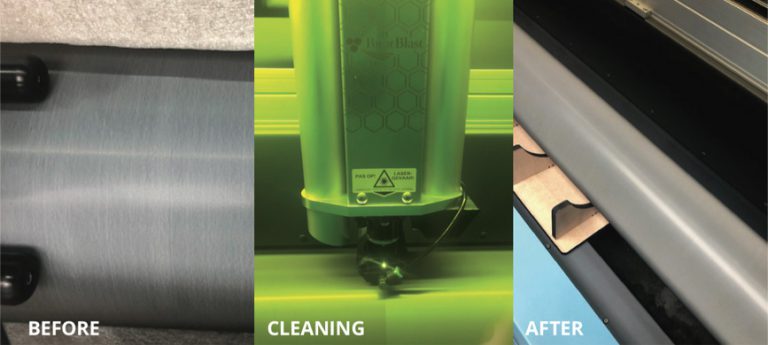15 June 2020
Deep cleaning anilox rolls by laser

JetCleaning launches innovative new system using MOPA laser
Demand for higher print quality in flexo is ever increasing. At the same time, turnaround times are getting shorter and margins are getting smaller. The need for a smooth and reliable printing process is evident. Netherlands-based JetCleaning now presents a new way to take care of at least one crucial part of the that process: deep cleaning anilox rolls and sleeves by the innovative use of a highly versatile and very efficient MOPA laser. Their first system was recently installed at Oerlemans Plastics, producer of flexible packaging and films.
Fast, Thorough and Safe
Although cleaning anilox rolls by laser has been around for some time, Niels Gerrits, founder of BicarBlast, has just spend two years developing and engineering a better and more reliable method: “Current laser cleaning almost inevitably causes damage to the cells or to the surface of the anilox rolls and sleeves. We have now managed to come up with a solution that ensures safe, fast and thorough cleaning by MOPA laser.”

Powder blasting for deep cleaning
JetCleaning provides a range of eco-friendly liquid cleaners for daily and periodical cleaning. It however specializes, as the company’s name implies, in deep cleaning anilox rolls by blasting them with powder (sodium bicarbonate, or NaHCO3). “This powder is hard enough to clean anilox rolls, but at the same time it is too soft to cause any damage”, explains Gerrits. Using low blast pressure, up to only 3 bar, further ensures no damage will occur to the ceramic or chrome plated anilox roll. Powder blast cleaning can be done either off site or on site, and also in-press. It is a fast and very effective way of cleaning, and JetCleaning has established a wide portfolio of customers throughout Europe – currently mainly in the corrugated industry. “Our method is a perfect fit for their anilox rolls, which feature 80 to 160 relatively large cells per cm. Now, the excellent cleaning results we are delivering today have also caught the attention of others, especially printers from the labelling and flexible packaging industry.”
Cleaning by laser – re-invented
In labelling and flexible packaging, there is a growing demand for higher print quality – and so, the need for perfectly clean anilox rolls is increasing, finds Gerrits: “We have been adding quite some new customers in this field.” However, in their efforts to enhance quality, these printers are increasingly using anilox rolls with finer, smaller cells. The size of these cells is preventing the powder-particles from effectively reaching deep into the cells. Gerrits comments: “Of course, we do also provide chemicals and dedicated machines that perfectly clean these anilox rolls. But many customers are not too keen on chemicals anymore – for environmental reasons, but also because of the costs involved with it, such as the protective measures that need to be implemented and the disposal of chemicals. Plus, they know there actually is new technology available: cleaning by laser. And that is what they are now looking for.” Niels Gerrits recognized the potential of laser cleaning already early on, but found the existing fiber laser technology inadequate because of the damage it can cause to the cell structure and surface of the anilox roll or sleeve. “The laser should only remove any ink contamination from the cells by ablation, and leave the cells and the surface completely in tact. But this is really hard to achieve.” For that reason, two years ago, he set out to reinvent laser cleaning the right way.

MOPA makes all the difference
Key to the new method is the use of a different type of laser called MOPA (short for Master Oscillator Power Amplifier). “We found a highly skilled partner that specializes in laser engraving and marking, using MOPA laser technology. What sets this laser technology apart from the more commonly used fiber laser technology, is that it allows us to set both the pulse frequency and pulse time in order to better control the cleaning process. It has taken us a considerable amount of time and effort to perfectly tune this technology to our needs. But I am happy to say that we have managed to succeed and now come up with a completely new and innovative solution: the AL1500 Cleaning Laser.

Successful first installation at Oerlemans
Already, JetCleaning has installed its first laser cleaning system at Oerlemans Plastics, producer of flexible packaging and films in the Netherlands. Gerrits: “They were looking for a new cleaning solution and we managed to convince them to decide for our new technology.” Results so far have been excellent: “Cleaning an anilox roll is much faster than before and costs are down by around 75 per cent.
Extensive testing
Oerlemans has also been running extensive tests, putting one anilox sleeve through 250 cleaning cycles on the AL1500 Cleaning Laser: ‘There has been absolutely no damage to the ceramics or the cell structure at all.” These test have been confirmed by independent industry-consultant Wilbert Streefland (owner of Technology Coaching BvbA): “A cleaning laser needs to be powerful enough to agitate and/or evaporate the ink residues in the engraving on the surface of the screen roll. At the same time it should never be so powerful that it is melting (engraving) and/or evaporating the ceramics on the surface of the screen roll.” By measuring the surface-temperature of the sleeve during laser cleaning, Streefland was able to register an surface temperature of 30.3 °C maximum: “This means no stress in the ceramic surface layer and also no risk for melting the ceramic layer.”
Niels Gerrits sees great further potential for BicarBlast’s laser cleaning technology. At the same time he expects the powder blast cleaning technology to continue its success: “Both technologies have their specific applications. Powder blasting is still perfect for cleaning most anilox rolls in coating and corrugated. But for cleaning the increasing number of ‘high quality’ anilox rolls, our laser technology will be the future.”


